Spatial Ability Tests
These questions evaluate how well you can visually manipulate and assemble two-dimensional (2D) and three-dimensional (3D) shapes as described in the diagram below. Spatial ability can be defined as: 'The ability to interpret and make drawings, form mental images, and visualize movement or change in those images.'
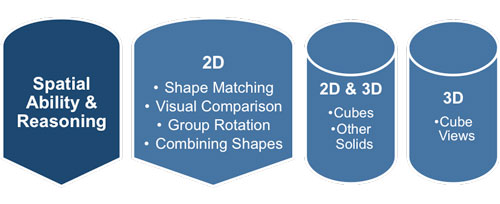 |
Spatial ability tests are a combination of speed and power tests, as the following examples illustrate. These types of question are often used in scientific and engineering management selection.
Shape Matching - 2D shapes
These questions require an individual to manipulate of 2D objects then they are probably fairly straightforward, but you will be challenged to answer them all in the time you are given. It is important to read the question carefully so that you understand exactly what you are being asked to identify:
- One-to-one match of shapes.
- Match shapes that have been repositioned and possibly rotated in some instances.
- Identify missing or mirrored shapes.
1. Which shape in Group 2 corresponds to the shape in Group 1?
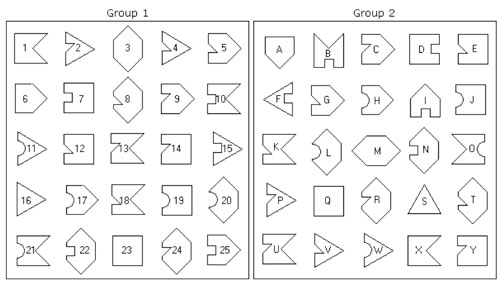 |
Answers
1. X 2. P 3. M 4. V 5. G
6. A 7. D 8. T 9. C 10. B
11. W 12. E 13. U 14. Y 15. F
16. S 17. H 18. K 19. J 20. L
21. O 22. N 23. Q 24. R 25. I
When presented with a large number of shapes as in this example many people find it distracting and stressful to answer. This is where your practice of such questions is vital to your success because it identifies your best strategy for answering it quickly and accurately. For example, you can work sequentially through Group 1 or spot the matches by visually comparing the two groups.
Visual Comparison of 2D Shapes
These questions require you to spot the only two identical objects in the selection. You need to be able to work through this type of question quickly. Two useful strategies are:
• Cover up the other questions so you are not distracted by them.
• Try to match the far left shape first and move through the row systematically until you find the pair of matching shapes.
 |
26. Which two pictures are identical?
26 - C & E.
Group Rotation of 2D objects
These are more complex than the previous group. The most effective strategy is to work in terms of clockwise and counterclockwise rotations and to select one shape in the group - often the most asymmetrical shape - and find its rotation options first, and then work through the other shapes to find the answer.
27. Which of the Answer Figures is a rotation of the Question Figure?
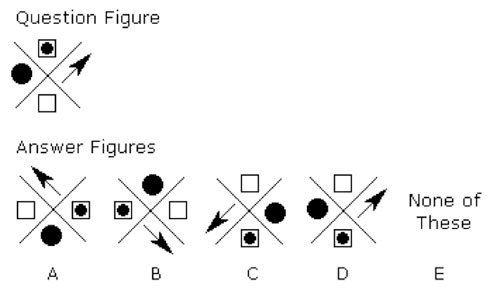 |
27 - C (Explanation - the white square is clockwise from the arrow. So A, B, and D cannot be rotations of the Question Figure, leaving only C which you'll quickly check element by element to ensure you're right.)
Combining 2D Shapes
You will be asked to put together the 2D cut pieces or components so that they make one of the complete shapes shown. The best strategy for this style of question is to look for any distinct feature that makes it impossible to construct the complete shape from the given components.
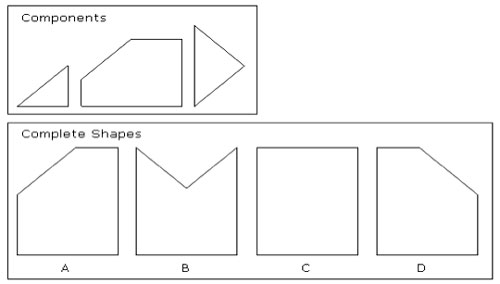 |
28. Which of the Complete Shapes can be made from the Components shown?
28 - B (Tip: in this example the complete shape has no sticking out parts, which tells you that the components fit together so that sides of the same length are together.)
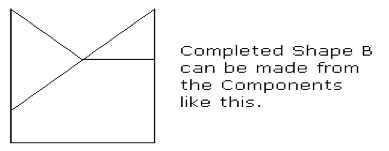 |
3D Cube Views
You are usually shown three views of a cube in 3D. Each face will have a unique symbol on it, or be blank. You will then be asked to identify the symbol opposite the stated one, i.e. which one is on the opposite face. Only by practicing such questions will you find the best strategy for you to quickly identify the answer.
 |
29. Three views of the same cube are shown below. Which symbol is opposite the X?
29 - D (Tip: you can eliminate the symbols A, B, and C on the cubes showing the 'X' because these cannot be opposite it. This leaves 'D' and 'other.' But as D has edges shared with A and B that are consistent with the third cube it is the answer.)
Unless it is stated in the question it is implicit that each symbol is only used once. This means that rotating a cube in a clockwise or counterclockwise direction will help find the answer.
Cubes in 2D and 3D
In these questions you will be asked to make a cube up from a 2D pattern or to identify the 2D pattern that makes up the 3D cube shown. Each face will have a symbol or design on that you will manipulate in your mind's eye to create the pattern or cube that is the answer, as shown in the examples below.
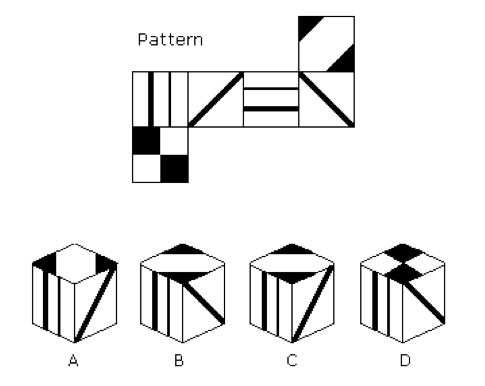 |
30. Which of the cubes shown could be made from the pattern?
30 - A (Tip: each answer can only show three faces of the cube so look at the relationship between these three elements and see if it is in the pattern. Name one face the top and then name the others in relation to it as shown below.)
 |
31. Which of the patterns when folded will make the cube shown?
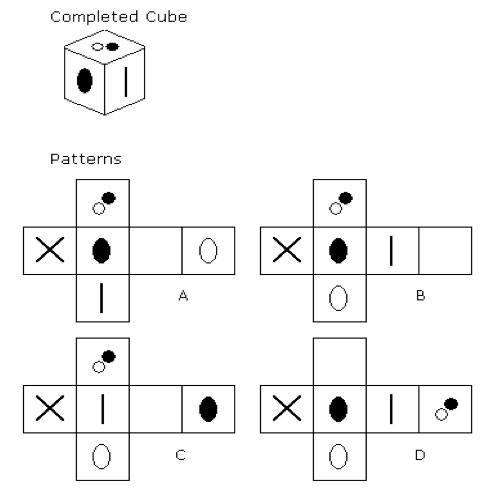 |
31 - B (Use the same strategy as above: name the faces and look for relationships between them.)
Other Solids in Two and Three Dimensions
In these questions you will be asked to perform the same task but using other shapes, which can be irregular. Many individuals find these questions easier than the cube ones because each face of the solid shape is different. This makes it easier to identify the relationships between them, as shown in the example below.
32. Which of the solid shapes shown could be made from the pattern?
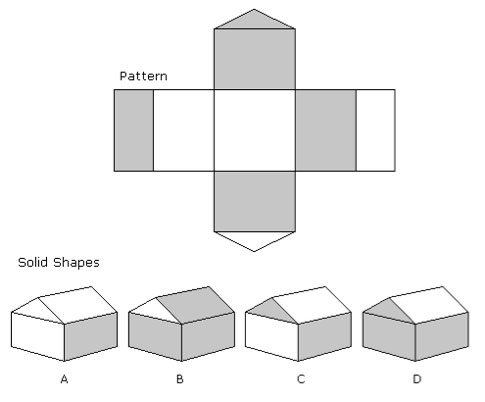 |
32 - D (Explanation - A and C can be eliminated because they show an unshaded face below a triangular face. B is eliminated because it has a shaded roof above the shaded side. None of these appear on the pattern.)
Spatial tests rely on an individual's ability to visualize in their mind's eye how the 2D or 3D shape alters and this is not an innate skill that comes easily to everyone. So it is essential to practice these types of spatial ability questions because with only 20-40 minutes to answer between 20-30 questions every second counts if you want to achieve a high score.
You may also be interested in:
Management Aptitude Tests | Verbal Ability and Reasoning Tests | Numerical Ability and Reasoning Tests | Abstract Reasoning Tests | Spatial Ability Tests | Scoring and Ranking Results.


